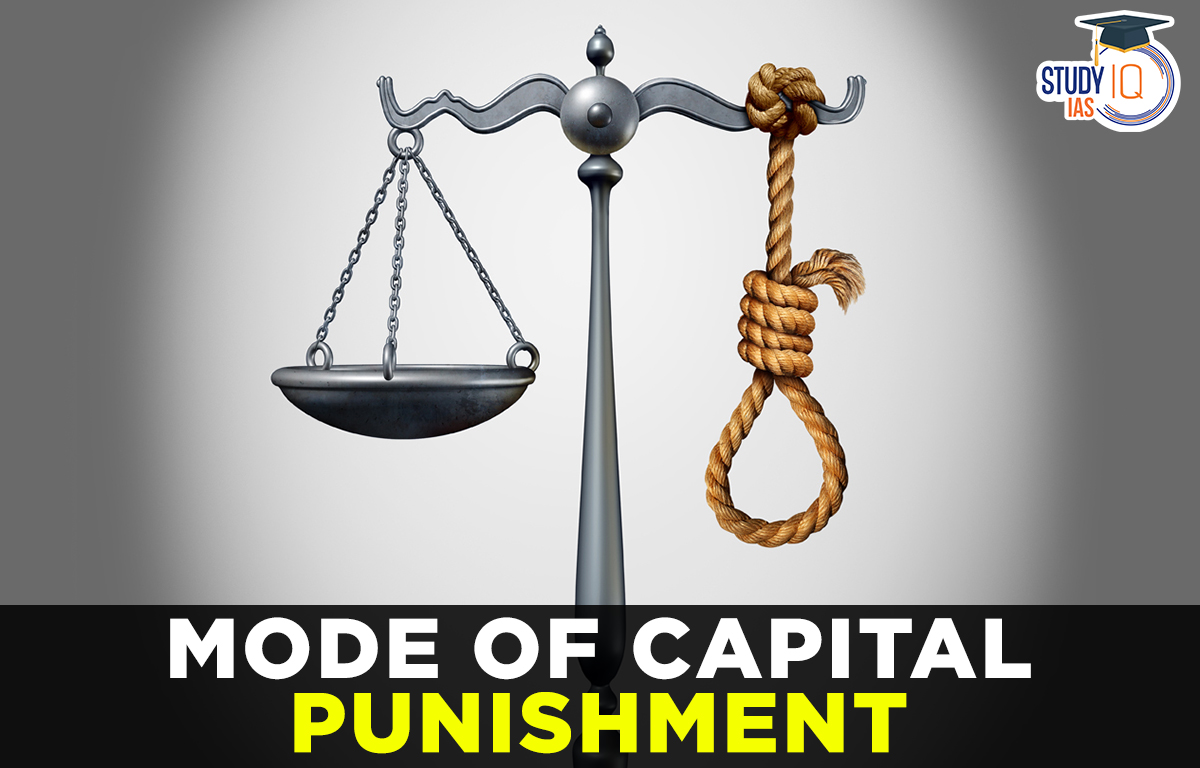Table of Contents
Context: A bench led by Chief Justice of India (CJI) is reopening a decades-old debate over whether there can be a more humane and dignified way of executing the death penalty or capital punishment.
What is Capital Punishment?
- Death penalty, also known as capital punishment, can be defined as ‘a practice sanctioned by law whereby a person is put to death by the state as a punishment for a crime after a proper legal trial’.
- India is among the few countries that retains capital punishment under different laws for serious offences.
- Offences for capital punishment: Certain offences under Indian Penal Code, for which the offenders can be sentenced to punishment of death are:
- Murder (Section 302)
- Dacoity with murder (Section 396)
- Criminal Conspiracy (Section 120B)
- Waging war against the Government of India or attempting to do so (Section 121)
- Abatement of mutiny (Section 132) and others.
- Mode of capital punishment: Section 354(5) of the Code of Criminal Procedure (CrPC), 1973 reads “When any person is sentenced to death, the sentence shall direct that he be hanged by the neck till he is dead.”
- Also, the Air Force Act, 1950, The Army Act 1950, and The Navy Act 1957 say that execution has to be carried out either by hanging by the neck until death or by being shot to death.
- Legal evolution of death penalty in India:
- Bachan Singh vs State of Punjab (1980): A five-judge Bench of the Supreme Court upheld the constitutional validity of the death sentence by a 4:1 majority ruling.
- Machhi Singh vs State of Punjab (1983): The Supreme Court laid down guidelines for awarding the death penalty in cases of murder.
- Shatrughan Chauhan vs Union of India (2014): The Supreme Court held that undue delay in deciding mercy petitions would be a ground for commutation of the death penalty.
- Mercy power: Death sentence can be commutated into life imprisonment or pardoned by the President under Article 72 of Indian Constitution.

What is the Debate around the Capital Punishment or Death Penalty by Hanging?
- The debate around the mode of death penalty by hanging revolves around whether it constitutes cruel, inhuman, and degrading treatment or punishment, and whether there are less painful alternatives available.
- In 2017, an advocate filed a public interest petition (PIL) seeking a more dignified way to execute the capital punishment. Then the Supreme Court had issued notice to the Centre.
- The Centre’s stand: In its 2018 affidavit, the government had argued that death by hanging was the only “viable” option to execute a death warrant.
- Recommendation of the Law Commission: In its 187th report in 2003, the Law Commission of India recommended that Section 354(5) of the CrPC should be amended by providing an alternative mode of execution of death sentence by “lethal injection until the accused is dead”.
- The report suggested that it should be the discretion of the judge to pass appropriate orders regarding the mode of execution of death sentence.
- It also suggested to hear the convict on the question of mode of execution of death sentence before passing the discretionary order.
What is the Practice in other Countries?
- Death sentence around the globe: According to Amnesty International, 55 countries around the world have the death sentence on the books.
- Death by hanging: Death by hanging is still the most prevalent form of execution, especially in the former British colonies.
- Other forms of death sentence:
- In the United States, for example, an intravenous lethal injection is given in every state (27 states and American Samoa) that allows the death penalty.
- Electrocution is a secondary method in some states.
- Execution by firing squad is employed in China, and Saudi Arabia uses beheading apart from other methods.


 Securities Markets Code Bill 2025: Towar...
Securities Markets Code Bill 2025: Towar...
 Weakly Interacting Massive Particles (WI...
Weakly Interacting Massive Particles (WI...
 India–Oman Trade Deal: CEPA Signed to ...
India–Oman Trade Deal: CEPA Signed to ...

























